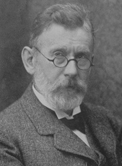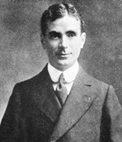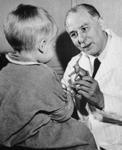DTP Branches and Offices
Milestone (1900)

Roswell Park Memorial Institute (Buffalo, New York). Courtesy of NCI. 1901.

Dr. Paul Ehrlich. Courtesy of the Edgar Fahs Smith Collection, Michigan State University, Department of Chemistry.

Dr. George H.A. Clowes. Courtesy of NCI. 1917.

Dr. Sidney Farber. Courtesy of NCI. 1960.
Early drug development
“Design of successful drugs must take into account aspects of a tumor cell’s molecular contexts, metabolism, and architecture. Development schemes to emphasize ‘real-time’ confirmation in pre-clinical models as well as in early clinical trials that a drug is having the desired effect on its intended target and delivery to target tumor cell populations would be optimal and should be seriously considered as adding value….”1
Drs. Paul Ehrlich, George Clowes, and Sidney Farber were pioneers in the cancer treatment field.
Dr. Ehrlich coined the term “chemotherapy” before 1900 and advocated the use of animal models to study the effects of drugs on diseases. Among his achievements were the synthesis and testing of hundreds of organic arsenical compounds for the treatment of syphilis, resulting in the discovery of arsphenamine (salvarsan, compound #606), the first synthetic chemical shown to be an effective treatment for a human parasitic disease.
At the same time, the demonstration that a cure for a human disease could be found using a rodent model inspired Dr. Clowes, working at Roswell Park Memorial Institute, to develop rodent models that could carry transplanted rodent tumors. He is credited with initiating the first cancer chemotherapy program in the United States.
Sidney Farber’s study of folic acid effects on childhood leukemia led to the development of antifols as anticancer drugs and a concerted effort towards the discovery of chemotherapeutic agents. His findings, published in the New England Journal of Medicine in 1948, generated excitement; never before had a drug been shown to be effective against leukemic tumors. Nevertheless, success with nitrosoureas and antifols led to efforts to discover new drugs focused on analogs of these compounds.
1 Sausville EA, Johnson JI. Molecules for the millennium: how will they look? New drug discovery year 2000. Br J Cancer. 2000;83:1401-1404.





